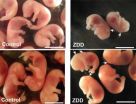(Press-News.org) Female insects have one goal in life: to find the best place to lay their eggs. For fig wasps, that is the developing fruit of the luscious fig plant. However, when one particular parasitic fig wasp (Apocryta westwoodi grandi) descends onto a recently fertilised fruit, she has to bore her way through the tough unripe fig to find the larvae of other insects that are already developing within, which she will then parasitize to give her own eggs the best start. Fortunately, the insect's immensely long (7–8mm) and slender (~15 μm) ovipositor – which injects eggs into the fig – is equipped with a sharp tip, ready to bore through the woody fruit. However, Namrata Gundiah from the Indian Institute of Science, Bangalore, was intrigued by the differences between the egg delivery systems of the boring parasitoid wasps and the wasps that pollinate the fig's flowers. 'Our first question was what are the different adaptations that these two species undergo?' says Gundiah. She publishes her discovery that the tiny fig wasps are equipped with a zinc tipped drill bit for boring in The Journal of Experimental Biology at http://jeb.biologists.com.
Teaming up with graduate student Laksminath Kundanati, Gundiah used scanning electron microscopy to take a high resolution look at the tips of the insects' ovipositors and was amazed to see that the end of the boring wasp's ovipositor looked like a drill bit, complete with teeth to bore through the woody fruit. In contrast, the tip of the pollinator wasp's ovipositor closely resembled a spoon-like structure. And, when they looked along the length of the borer's ovipositor, Kundanati and Gundiah noticed tiny pits in the shaft, roughly in the location where the structure bends as the female drives the tip into the fruit to allow the ovipositor to flex without breaking. They could also clearly see sensory structures at the tip that could help guide the ovipositor to the best locations for the wasp to lay her eggs.
Next, the duo investigated the material from which the drill bit was made. 'We asked what could enhance the hardness of the structures', recalls Gundiah. Focusing a beam of electrons on the minute tip, Kundanati and Gundiah recorded the X-ray spectra emitted by the material and discovered that the tooth structures were enriched with zinc. 'Zinc mainly increases the hardness, which will affect the wear resistance of the drill bits', explains Gundiah.
Kundanati and Gundiah then prodded the minute drill bit with an atomic force microscope (AFM) probe to indent it to measure how hard the zinc-enriched teeth were. Gundiah admits that pinpointing the tiny teeth on the miniscule curved structure was particularly challenging: 'Usually, AFM is done on relatively large surfaces and so it doesn't matter where you go and indent the material', chuckles Gundiah. But eventually the duo recorded the hardness of the teeth at 0.5 GPa: 'That is almost as hard as the acrylic cement used for dental implants', says Gundiah.
Finally, knowing that the females impale unripe figs with their ovipositors many times during the course of their lives, Gundiah decided to measure the buckling forces exerted on the slender structure as the female drives the ovipositor in. Kundanati filmed the tiny wasps on fig trees around the institute campus by attaching a microscope objective to a video camera. He clearly saw the slender structures bend and flex as the insect drove it in and calculated that the 15 μm diameter structure can tolerate buckling forces of almost 7 μN.
Having characterised the fig wasp's drill bit, Gundiah is keen to design a minute boring tool based on the lessons that she has learned from the insects.
INFORMATION:
IF REPORTING THIS STORY, PLEASE MENTION THE JOURNAL OF EXPERIMENTAL BIOLOGY AS THE SOURCE AND, IF REPORTING ONLINE, PLEASE CARRY A LINK TO: http://jeb.biologists.org/content/217/11/1946.abstract
REFERENCE: Kundanati, L. and Gundiah, N. (2014). Biomechanics of substrate boring by fig wasps. J. Exp. Biol. 217, 1946-1954.
This article is posted on this site to give advance access to other authorised media who may wish to report on this story. Full attribution is required, and if reporting online a link to jeb.biologists.com is also required. The story posted here is COPYRIGHTED. Therefore advance permission is required before any and every reproduction of each article in full. PLEASE CONTACT permissions@biologists.com
Parasitic fig wasps bore with zinc-hardened drill bit tips
2014-05-29
ELSE PRESS RELEASES FROM THIS DATE:
What shaped it, how old is it, and are they connected?
2014-05-29
Boulder, Colo., USA - Two articles recently published online for the journal LITHOSPHERE investigate the influence of climate, erosion, and tectonics on the lay of the land in the Bolivian Andes. Nicole Gasparini of Tulane University and Kelin Whipple of Arizona State University tackle rainfall patterns, rock uplift, and the distribution of crustal deformation caused by tectonics. In both studies, they conclude that tectonics win out over rainfall when it comes to shaping Earth' surface in the area.
Other new articles cover (1) isotopic dating of volcanic rocks in the ...
UT Arlington nursing professor studying online students' stress, sense of belonging
2014-05-29
As a nursing professor assigned to one of UT Arlington's first online master's degree courses, Ronda Mintz-Binder had a stake in learning to motivate students online. Now, she's building on her experience with a research project that will help other professors.
Mintz-Binder, who holds a master's degree in psychiatric/mental health nursing and a doctorate in nursing educational leadership, received two grants from the Dallas-based education company Academic Partnerships to initiate a multi-year study comparing the experiences of on-campus and online master's degree students. ...
Microalgae capable of assimilating the NH3 resulting from the management of agrifood waste
2014-05-29
The Basque Institute for Agricultural Research and Development, Neiker-Tecnalia, the public body that reports to the Sub-Ministry for Agriculture, Fisheries and Food Policy of the Government of the Basque Autonomous Community, has confirmed the capacity of Chlamydomonas acidophila microalgae to absorb ammoniacal nitrogen present in the effluent generated in the digestion of organic waste coming from the agri-food sector. These algae can grow in these liquids and assimilate the ammonium, which prevents this gas from being volatilised in the form of ammonia (NH3) and contaminating ...
Dentists' knowledge, confidence tied to care for scleroderma patients
2014-05-29
What: A survey of dentists in Massachusetts suggests that their confidence in treating patients with scleroderma may be related to their familiarity with the autoimmune disease. Dentists who reported feeling knowledgeable about scleroderma felt more prepared to provide care to patients with scleroderma, when compared to peers who did not feel as knowledgeable. Providing education to dentists may improve patient satisfaction and access to care, while simultaneously increasing dentists' knowledge and comfort.
Background: Scleroderma, derived from the Greek words for "hard ...
Zinc deficiency before conception disrupts fetal development
2014-05-29
Female mice deprived of dietary zinc for a relatively short time before conception experienced fertility and pregnancy problems and had smaller, less-developed fetuses than mice that ingested zinc during the same times, according to researchers in Penn State's College of Agricultural Sciences.
The findings have implications for human reproduction, scientists suggest.
Going without zinc prior to ovulation had marked effects on the mice's reproductive functions. Zinc deficiency caused a high incidence of pregnancy loss, and embryos from the zinc-deficient diet group were ...
Spruce up your selfie
2014-05-29
CAMBRIDGE, Mass-- Celebrated portrait photographers like Richard Avedon, Diane Arbus, and Martin Schoeller made their reputations with distinctive visual styles that sometimes required the careful control of lighting possible only in the studio.
Now MIT researchers, and their colleagues at Adobe Systems and the University of Virginia, have developed an algorithm that could allow you to transfer those distinctive styles to your own cellphone photos. They'll present their findings in August at Siggraph, the premier graphics conference.
"Style transfer" is a thriving area ...
Having children is contagious among high school friends during early adulthood
2014-05-29
WASHINGTON, DC, May 22, 2014 — A new study suggests that having children is contagious among female high school friends during early adulthood.
"The study shows the contagion is particularly strong within a short window of time: it increases immediately after a high school friend gives birth, reaches a peak about two years later, and then decreases, becoming negligible in the long-run," said co-author Nicoletta Balbo, a postdoctoral fellow at the Carlo F. Dondena Centre for Research on Social Dynamics at Bocconi University in Italy. "Overall, this research demonstrates ...
Where one lives matters in the relationship between obesity and life satisfaction
2014-05-29
WASHINGTON, DC, May 27, 2014 — A new study suggests that how one compares weight-wise with others in his or her community plays a key role in determining how satisfied the person is with his or her life.
"The most interesting finding for us was that, in U.S. counties where obesity is particularly prevalent, being obese has very little negative effect on one's life satisfaction," said study co-author Philip M. Pendergast, a doctoral student in sociology at the University of Colorado-Boulder. "In addition, we found that being 'normal weight' has little benefit in counties ...
Circumcision linked to reduced risk of prostate cancer in some men
2014-05-29
Circumcision is performed for various reasons, including those that are based on religion, aesthetics, or health. New research indicates that the procedure may help prevent prostate cancer in some men. The findings, which are published in BJU International, add to a growing list of advantages to circumcision.
Besides advanced age, African ancestry, and family history of prostate cancer, no other risk factors for prostate cancer have been definitively established. This has fuelled the search for modifiable risk factors. Marie-Élise Parent, PhD and Andrea Spence, PhD, ...
Researchers address major geographic disparities in access to kidney transplantation
2014-05-29
There is substantial geographic variation in access to kidney transplantation among the more than 4000 US dialysis facilities that treat patients with kidney failure, with a disproportionate lack of access to those in the Southeast. Certain factors, which are described in several papers published in the American Journal of Transplantation, seem to explain these differences, and they underscore the need for political, financial, and health systems changes to reduce transplant inequities across the country.
Researchers have noticed variability in transplant rates between ...

